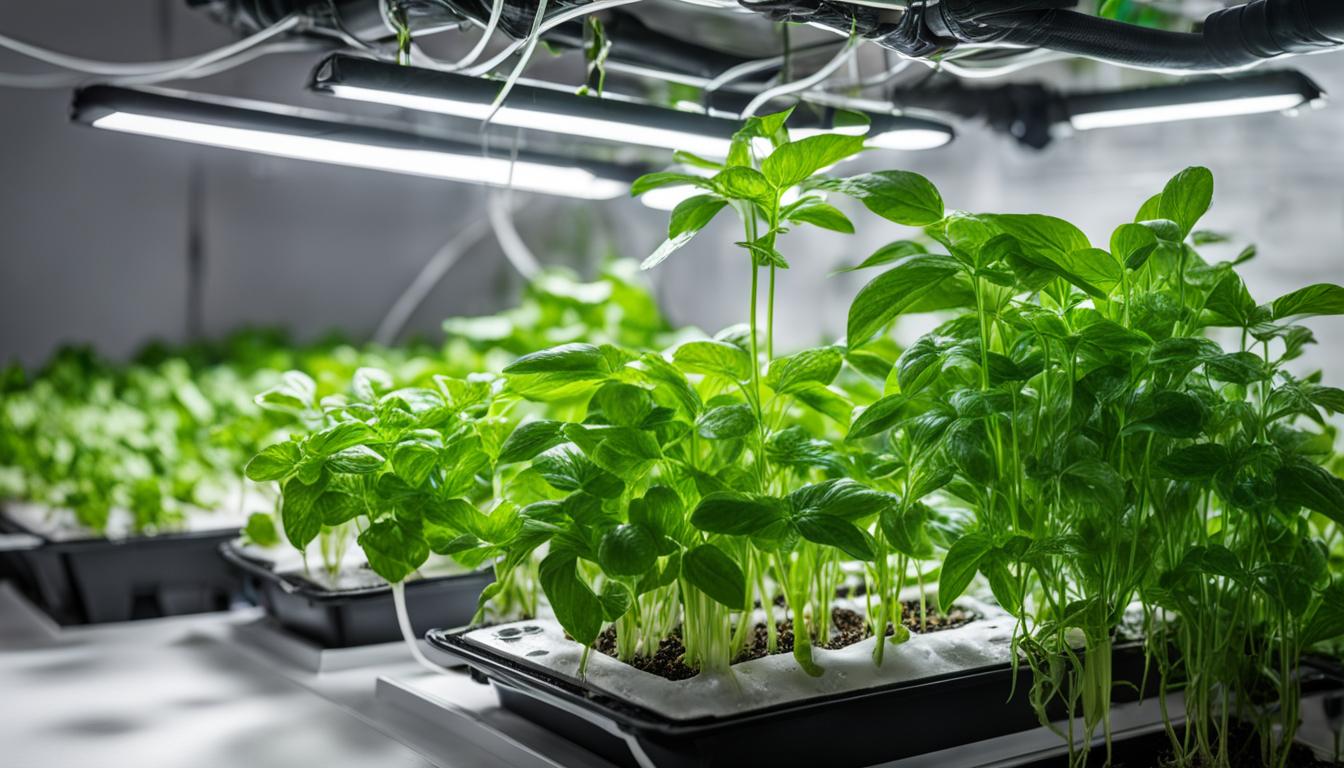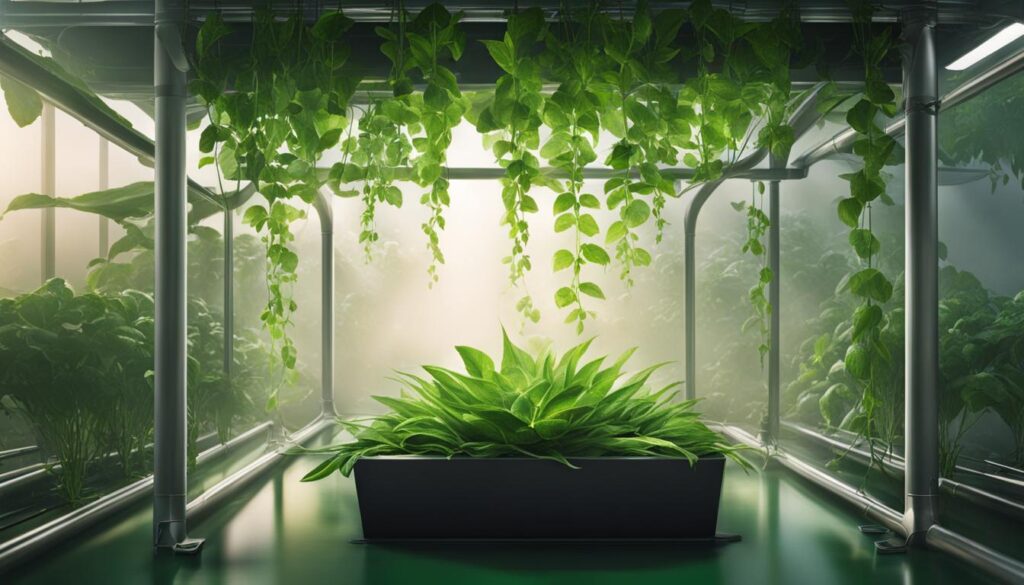
Aeroponic systems, a type of soil-less cultivation method, have shown significant potential in improving plant growth. By suspending plant roots in air and providing them with a nutrient-rich mist, aeroponic systems offer several benefits.
Firstly, the exposure to atmospheric levels of gases, such as oxygen, enhances plant health and leads to faster growth. This results in increased crop cycles per year and a greater yield. Additionally, aeroponic systems allow for precise application of nutrient solutions, tailored to specific crop needs.
They also reduce the risk of pests and diseases due to the dry environment. Furthermore, aeroponics contributes to environmental sustainability by reducing water and fertilizer use.
Overall, the use of aeroponic systems can revolutionize plant growth and increase the efficiency of farming.
Key Takeaways:
- Aeroponic systems suspend plant roots in air and provide a nutrient-rich mist.
- The exposure to atmospheric gases enhances plant health and leads to faster growth.
- Precise nutrient application and reduced risk of pests and diseases are among the benefits of aeroponic systems.
- Aeroponics reduces water and fertilizer use, contributing to environmental sustainability.
- Aeroponic systems have the potential to revolutionize plant growth and increase farming efficiency.
What is Aeroponics and How Does It Work?
Aeroponics is an innovative soil-less cultivation technique that offers numerous benefits for farmers and growers. In aeroponic systems, plant roots are suspended in the air and periodically misted with a nutrient-rich solution, providing them with essential water, oxygen, and nutrients for optimal growth.
Unlike hydroponics or aquaponics, which uses water as a growing medium, aeroponics eliminates the need for any medium, making it a more efficient and sustainable method of plant cultivation.
By misting the roots, aeroponic systems enable maximum nutrient absorption, faster growth rates, and higher yields compared to traditional soil-based farming methods. The exposure to atmospheric gases, especially oxygen, stimulates root development and enhances plant health, resulting in robust and healthy plants.
This method also allows for precise control over nutrient solutions, ensuring that plants receive the optimal amount of nutrients tailored to their specific needs.
The absence of soil or growing media in aeroponics reduces the risk of pests, diseases, and soil-borne pathogens, contributing to healthier and more sustainable plant growth.
In addition to its benefits for plants, aeroponics offers advantages for farmers as well. These systems allow for efficient use of resources, including space, water, and fertilizers.
By eliminating the need for soil, aeroponic systems maximize the available cultivation area, making it possible to grow crops in urban environments or areas with limited land availability. The precise control over nutrient solutions also minimizes water consumption and fertilizer usage, leading to cost savings and environmental sustainability.
Aeroponics provides farmers with an innovative and effective method of achieving higher yields, maximizing operational efficiency, and ultimately increasing profitability.
Comparison between aeroponic systems and traditional soil-based cultivation:
| Aeroponics | Traditional Soil-Based Cultivation | |
|---|---|---|
| Water Usage | Minimal water usage due to misting | Higher water consumption due to evaporation and inefficient watering |
| Nutrient Absorption | Optimal nutrient absorption due to precise control over nutrient solutions | Varies depending on soil quality and nutrient availability |
| Pest and Disease Risk | Reduced risk due to absence of soil | Higher risk due to soil-borne pests and diseases |
| Space Efficiency | Maximizes available cultivation area | Requires larger land area for traditional farming |
| Yield | Higher yield potential | Varies depending on soil fertility and environmental conditions |
Benefits of Aeroponic Systems
Aeroponic systems offer numerous advantages that make them a compelling choice for plant cultivation. These systems provide precise control over nutrient solutions, allowing for customized care tailored to the specific needs of each crop.
This results in faster growth, higher quality produce, and increased yields. Additionally, the absence of soil or growing media in aeroponic systems reduces the risk of pests, diseases, and soil-borne pathogens, leading to healthier plants and improved overall plant health.
Precise Nutrient Control
One of the key benefits of aeroponic systems is the ability to tailor nutrient solutions to the specific requirements of each crop. With precise control over the nutrient composition and delivery, farmers can optimize plant growth and development.
This results in faster growth rates, improved plant health, and higher-quality produce. Additionally, the precise nutrient control minimizes nutrient wastage and reduces the environmental impact of farming.
Reduced Pest and Disease Risks
Aeroponic systems eliminate the need for soil or growing media, which reduces the risk of pests, diseases, and soil-borne pathogens. Without a suitable environment for pests and pathogens to thrive, plants grown in aeroponic systems are less susceptible to infestations and diseases.
This translates to healthier plants that require fewer pesticides and fungicides, promoting a more sustainable and environmentally friendly approach to plant cultivation.
Efficient Resource Utilization
Aeroponic systems offer efficient use of resources, making them beneficial for farmers. These systems require less water and fertilizers compared to traditional cultivation methods, minimizing resource consumption and reducing the environmental impact.
The ability to grow crops in limited spaces and urban environments further optimizes land utilization and maximizes productivity. Overall, aeroponic systems enable farmers to achieve higher efficiency and profitability while promoting sustainability in agriculture.
| Advantages of Aeroponic Systems |
|---|
| Precise control over nutrient solutions |
| Reduced risk of pests and diseases |
| Efficient use of resources |
Aeroponics vs Other Cultivation Methods
When it comes to cultivating plants, aeroponics offers several advantages over traditional soil-based methods and even hydroponics. Let’s take a closer look at how aeroponics compares to other cultivation methods:
Aeroponics vs Soil-Based Cultivation
Unlike traditional soil-based cultivation, aeroponics eliminates the need for soil or growing media. This means there is a reduced risk of soil-borne diseases and pests, making it a more sustainable and environmentally friendly option.
Also, aeroponic systems allow for faster growth and higher yields due to the increased exposure of roots to oxygen.
Aeroponics vs Hydroponics
Compared to hydroponics, aeroponics offers even faster growth and higher yields. This is because the misting of plant roots in an aeroponic system provides optimal access to oxygen, promoting robust root development and nutrient absorption.
Aeroponics requires less water and fertilizers compared to both soil-based and hydroponic systems, making it a more efficient and resource-conscious cultivation method.
Aeroponics: The Sustainable Choice
Aeroponics excels in sustainability by minimizing the risk of pests, diseases, and soil-borne pathogens. The absence of soil or growing media reduces the need for chemical treatments, resulting in healthier plants and minimizing environmental impacts.
With precise control over nutrient solutions, aeroponics also minimizes water and fertilizer usage, making it a more sustainable choice. Furthermore, aeroponic systems maximize crop yields through efficient use of space and resources, reducing the need for land expansion and conserving water.
| Cultivation Method | Advantages |
|---|---|
| Aeroponics |
|
| Soil-Based Cultivation |
|
| Hydroponics |
|
Overall, aeroponics offers distinct advantages over other cultivation methods, making it an attractive choice for efficient and sustainable plant growth.
Increased Yield with Aeroponics
One of the primary benefits of using aeroponic systems is the potential for increased crop yield. By providing plant roots with an optimal environment of water, nutrients, and oxygen, aeroponics promotes faster and healthier growth.
The increased access to atmospheric gases, especially oxygen, enhances root development, leading to more robust plants. This, in turn, results in higher yields per crop cycle. The precise control over nutrient solutions in aeroponics also allows for better customization and optimization of plant growth.
Farmers can achieve increased yield and maximize the efficiency of their farming operations by incorporating aeroponic systems.
Aeroponic systems have revolutionized the way we approach crop cultivation, allowing for higher yields and improved efficiency. By suspending plant roots in air and misting them with nutrient-rich solution, aeroponics creates an ideal environment for optimal plant growth.
The exposure to atmospheric gases, particularly oxygen, stimulates root development and nutrient absorption, leading to faster and healthier growth. This increased efficiency in plant growth translates into higher yields per crop cycle, enabling farmers to maximize their productivity.
With precise control over nutrient solutions, aeroponics provides a tailored approach to plant care, further enhancing yield potential.
The Advantages of Using Aeroponic Systems
Utilizing aeroponic systems in plant cultivation offers several advantages that contribute to increased yield. Firstly, the controlled environment in aeroponics allows for optimal customization of nutrient solutions, ensuring that plants receive the exact nutrients they need for optimal growth.
This precise control results in faster growth rates, higher quality produce, and increased overall yield. Additionally, the absence of soil or growing media in aeroponics reduces the risk of pests and diseases, leading to healthier plants and a higher percentage of marketable produce.
The reduced water and fertilizer usage in aeroponics make it a more sustainable and environmentally friendly approach to agriculture. By incorporating aeroponic systems, farmers can achieve greater efficiency and higher crop yields, ultimately improving their profitability.
| Advantages of Using Aeroponic Systems |
|---|
| Increased yield potential |
| Optimal customization of nutrient solutions |
| Reduced risk of pests and diseases |
| Sustainable and environmentally friendly |
| Improved profitability for farmers |
Plant Growth in Aeroponic Systems
Plant growth in aeroponic systems is significantly enhanced compared to traditional soil-based cultivation. The suspension of plant roots in air provides them with abundant access to atmospheric gases, particularly oxygen, which is crucial for various metabolic processes.
This oxygen-rich environment stimulates root development and nutrient absorption, leading to faster and healthier growth. The precise control over nutrient solutions in aeroponics ensures that plants receive the optimal amount of nutrients they need for optimal growth and development.
As a result, plants grown in aeroponic systems exhibit increased growth rates, higher crop yields, and improved overall plant health.
Aeroponic systems offer a sustainable approach to plant growth. By eliminating the need for soil or growing media, these systems reduce the risk of pests, diseases, and soil-borne pathogens, resulting in healthier plants.
The precise control over nutrient solutions in aeroponics also allows for efficient use of water and fertilizers, minimizing environmental impacts. Additionally, aeroponic systems promote resource efficiency by maximizing crop yields and reducing the need for land expansion.
The use of aeroponic systems in agriculture contributes to overall sustainability by conserving water, minimizing chemical usage, and promoting a more efficient use of resources.
The Benefits of Plant Growth in Aeroponic Systems
- Faster and healthier growth: Plant roots suspended in air have increased access to atmospheric gases, resulting in faster root development and nutrient absorption.
- Higher crop yields: The precise control over nutrient solutions in aeroponics ensures that plants receive the optimal amount of nutrients, leading to increased crop yields.
- Reduced risk of pests and diseases: The absence of soil or growing media in aeroponic systems reduces the risk of pests, diseases, and soil-borne pathogens, resulting in healthier plants.
- Sustainability: Aeroponic systems promote resource efficiency by minimizing water and fertilizer usage, conserving water, and reducing chemical usage, contributing to overall sustainability.
Overall, plant growth in aeroponic systems offers numerous benefits, including faster and healthier growth, increased crop yields, reduced risk of pests and diseases, and sustainability.
By harnessing the power of aeroponics, farmers and gardeners can optimize plant growth, improve operational efficiency, and contribute to a more sustainable future.

Reasons to Choose Aeroponic Systems
Aeroponic systems provide numerous benefits that make them an attractive choice for plant cultivation. Whether you’re a farmer, gardener, or urban grower, here are some compelling reasons to consider aeroponics:
1. Customized Care and Optimal Growth
Aeroponic systems offer precise control over nutrient solutions, allowing for tailored care based on the specific needs of different crops.
This customization enhances plant growth, resulting in faster development, higher-quality produce, and increased yields. By providing an optimal environment for plant roots, aeroponics promotes efficient nutrient absorption and robust growth.
2. Pest and Disease Control
The absence of soil or growing media in aeroponic systems significantly reduces the risk of pests, diseases, and soil-borne pathogens. This eliminates the need for extensive pesticide use and minimizes the potential damage to crops.
By creating a clean and controlled growing environment, aeroponics ensures healthier plants, reducing the need for chemical interventions.
3. Environmental Sustainability
Aeroponic systems are environmentally friendly due to their efficient use of resources. These systems require less water compared to traditional farming methods, as the misting of roots provides targeted hydration.
Also, the precise control over nutrient solutions minimizes fertilizer usage, reducing the environmental impact. The ability to grow crops in limited spaces also promotes sustainable urban agriculture.
| Reasons to Choose Aeroponic Systems | |
|---|---|
| Customized Care and Optimal Growth | Elevated growth rates, improved produce quality, and increased yields through tailored nutrient solutions. |
| Pest and Disease Control | Minimized risk of pests, diseases, and soil-borne pathogens, resulting in healthier plants and reduced need for pesticides. |
| Environmental Sustainability | Efficient use of resources, reduced water consumption, minimized fertilizer usage, and promotion of sustainable urban agriculture. |
With these advantages, aeroponic systems offer a viable solution for plant cultivation, providing optimal growth conditions, reducing environmental impact, and ensuring healthier crops.
Aeroponic System Benefits for Farmers
Farmers can reap numerous advantages by incorporating aeroponic systems into their agricultural practices. These innovative systems provide efficient use of resources, reduced water consumption, and increased profitability. With aeroponic systems, farmers can optimize crop yields while minimizing environmental impact.
One of the primary benefits of aeroponic systems for farmers is the efficient use of resources, including space. By eliminating the need for soil or growing media, aeroponic systems maximize the available cultivation area.
This makes it possible to grow crops in urban environments or areas with limited land availability. Farmers can make the most of their available space, increasing their overall productivity and profitability.
In addition, aeroponic systems minimize water consumption compared to traditional farming methods. The precise control over nutrient solutions allows for targeted application, ensuring that plants receive the optimal amount of water they need for growth. This water-saving feature not only benefits the environment but also reduces operational costs for farmers.
Furthermore, aeroponic systems reduce the risk of pests and diseases. Without soil or growing media, there is a lower likelihood of soil-borne pathogens and pests affecting the crops. This reduces the need for chemical pesticides or other interventions, leading to healthier plants and higher-quality produce.
| Benefits of Aeroponic Systems for Farmers |
|---|
| Efficient use of resources and space |
| Reduced water consumption |
| Minimized risk of pests and diseases |
| Increased profitability |
Overall, aeroponic systems offer farmers the opportunity to enhance their farming operations by utilizing efficient and sustainable methods. By maximizing resources, reducing water consumption, and minimizing the risk of pests and diseases, farmers can increase their profitability while cultivating healthier and higher-yielding crops.
Advantages of Using Aeroponic Systems
When it comes to plant cultivation, aeroponic systems offer a multitude of advantages that make them a preferred choice for farmers and gardeners. One of the key benefits is the precise control over nutrient solutions, allowing for customized care tailored to specific crop needs.
This not only promotes faster growth but also leads to higher quality produce and increased yields. By providing plants with the optimal amount of nutrients they require, aeroponic systems create an ideal environment for plant growth and development.
Aeroponic systems also eliminate the need for soil or growing media, reducing the risk of pests, diseases, and soil-borne pathogens. This results in healthier plants and minimizes the use of chemical pesticides, making it an environmentally friendly option.
Plus, the absence of soil allows for efficient use of space, making it possible to grow crops in limited areas or urban environments. This opens up new possibilities for farming in areas where traditional agriculture may not be feasible.
Benefits of Using Aeroponic Systems
- Precise control over nutrient solutions for customized care
- Faster growth and higher quality produce
- Increased yields per crop cycle
- Minimized risk of pests, diseases, and soil-borne pathogens
- Environmentally friendly with reduced chemical usage
- Efficient use of space, ideal for urban farming
Furthermore, aeroponic systems minimize water and fertilizer usage compared to traditional farming methods. The nutrient-rich misting of plant roots ensures efficient nutrient absorption and reduces wastage.
This not only conserves water but also lowers the overall cost of plant cultivation. With its many advantages, aeroponic systems contribute to improved plant growth, operational efficiency, and profitability for farmers.
| Aeroponic Systems | Traditional Soil-Based Cultivation | Hydroponics | |
|---|---|---|---|
| Control over nutrient solutions | ✔ | ✖ | ✔ |
| Faster growth | ✔ | ✖ | ✔ |
| Higher quality produce | ✔ | ✔ | ✔ |
| Increased yields per crop cycle | ✔ | ✔ | ✔ |
| Risk of pests and diseases | ✖ | ✔ | ✖ |
| Water and fertilizer usage | ✔ | ✖ | ✔ |
Overall, the advantages of using aeroponic systems make them a game-changer in the field of plant cultivation. From customized care and increased yields to reduced environmental impact and efficient use of resources, aeroponic systems offer a sustainable and effective solution for modern farming.
By harnessing the power of air and nutrient-rich mist, these systems are transforming the way we grow plants and opening up new possibilities for sustainable agriculture.
Aeroponics for Efficient Plant Growth
Aeroponics has emerged as a highly efficient method for plant growth, offering numerous benefits to farmers and gardeners. By suspending plant roots in air and providing them with a nutrient-rich mist, aeroponic systems create an ideal environment for optimal growth and development.
The exposure to atmospheric gases, particularly oxygen, enhances root development and nutrient absorption, resulting in faster growth rates and healthier plants. This increased efficiency in plant growth allows for higher crop yields and a more efficient use of resources, including water and fertilizers.
One of the key advantages of using aeroponic systems is the precise control over nutrient solutions, allowing for customized care tailored to specific crop needs.
This ensures that plants receive the optimal amount of nutrients they need for healthy growth and development. The absence of soil or growing media reduces the risk of pests, diseases, and soil-borne pathogens, further contributing to efficient and sustainable plant growth.
Aeroponic systems also minimize water consumption, making them an environmentally friendly option for plant cultivation.
Furthermore, the efficiency of aeroponic systems extends to their ability to maximize space utilization. Without the need for soil, aeroponic systems can be implemented in urban environments or areas with limited land availability, allowing farmers to make the most of their available cultivation area. This makes aeroponics an attractive option for urban farming and sustainable agriculture practices.
Aeroponic System Benefits for Farmers
For farmers, the benefits of using aeroponic systems are numerous. Firstly, these systems offer efficient use of resources, including space, water, and fertilizers.
Without the need for soil or growing media, aeroponic systems allow farmers to maximize their cultivation area and achieve higher crop yields. This not only improves operational efficiency but also contributes to increased profitability.
Additionally, aeroponic systems minimize the risk of pests and diseases, leading to healthier plants and higher-quality produce.
The precise control over nutrient solutions in aeroponics also enables farmers to customize care for their crops, resulting in faster growth, improved plant health, and increased yields. Overall, incorporating aeroponic systems into farming practices can improve productivity, sustainability, and profitability for farmers.
Advantages of Using Aeroponic Systems
The advantages of using aeroponic systems extend beyond efficient plant growth and increased yields. The absence of soil or growing media reduces the risk of soil-borne diseases and pests, making aeroponic systems a more sustainable and environmentally friendly option.
Compared to traditional soil-based cultivation, aeroponics requires less water and fertilizers, minimizing the impact on water resources and reducing chemical usage.
Furthermore, the ability to grow crops in limited spaces and urban environments makes aeroponics an attractive and viable option for farmers and gardeners looking to maximize their cultivation potential.
Aeroponic Systems for Sustainable Plant Growth
Aeroponic systems offer a sustainable approach to plant growth, providing numerous benefits and advantages. One of the key advantages is the elimination of soil or growing media, which reduces the risk of pests, diseases, and soil-borne pathogens, resulting in healthier plants.
By suspending plant roots in air and providing them with a nutrient-rich mist, aeroponic systems create an ideal environment for optimal growth.
Another advantage of aeroponic systems is the precise control over nutrient solutions. This allows for efficient use of water and fertilizers, minimizing environmental impacts.
By tailoring the nutrient solutions to the specific needs of each crop, farmers can optimize growth and reduce waste. This not only benefits plant health but also promotes resource efficiency and sustainability.
Aeroponic systems also offer increased efficiency in plant growth, resulting in higher crop yields. The exposure of plant roots to atmospheric gases, especially oxygen, stimulates root development and nutrient absorption, leading to faster growth rates and healthier plants. This increased efficiency allows for a more productive use of resources, including water and fertilizers.
In conclusion, the use of aeroponic systems in agriculture promotes sustainable plant growth by reducing the risk of pests and diseases, minimizing chemical usage, and optimizing the use of resources.
By implementing aeroponic systems, farmers can benefit from healthier plants, higher crop yields, and a more environmentally friendly approach to cultivation.
FAQ
Can aeroponic systems improve plant growth?
Yes, aeroponic systems have shown significant potential in improving plant growth. By suspending plant roots in air and providing them with a nutrient-rich mist, aeroponic systems enhance root development and nutrient absorption, resulting in faster growth rates, higher crop yields, and overall healthier plants.
What is aeroponics and how does it work?
Aeroponics is a soil-less cultivation technique where plant roots are suspended in air and periodically sprayed with a nutrient-rich solution. Unlike hydroponics, which uses water as a growing medium, aeroponics eliminates the need for any medium. The misting of the roots provides the plants with the necessary water, oxygen, and nutrients for optimal growth.
What are the benefits of aeroponic systems?
Aeroponic systems offer several advantages that make them a compelling option for plant cultivation. These benefits include precise control over nutrient solutions for tailored care and optimal growth, reduced risk of pests and diseases, minimized water and fertilizer usage, efficient use of space, and the ability to grow crops in limited spaces and urban environments.
How does aeroponics compare to other cultivation methods?
Compared to traditional soil-based cultivation, aeroponics eliminates the need for soil or growing media, reducing the risk of soil-borne diseases and pests. It also offers faster growth and higher yields compared to hydroponics due to increased root exposure to oxygen. Additionally, aeroponic systems require less water and fertilizers compared to both soil-based and hydroponic systems.
Can aeroponic systems increase crop yield?
Yes, one of the primary benefits of using aeroponic systems is the potential for increased crop yield. By providing plant roots with an optimal environment of water, nutrients, and oxygen, aeroponics promotes faster and healthier growth, leading to higher yields per crop cycle.
How does plant growth in aeroponic systems differ from traditional soil-based cultivation?
Plant growth in aeroponic systems is significantly enhanced compared to traditional soil-based cultivation. The suspension of plant roots in air provides abundant access to atmospheric gases, particularly oxygen, which stimulates root development and nutrient absorption. As a result, plants grown in aeroponic systems exhibit increased growth rates, higher crop yields, and improved overall plant health.
Why should I choose aeroponic systems?
There are several advantages to choosing aeroponic systems. These include precise control over nutrient solutions for tailored care, reduced risk of pests and diseases, minimized water and fertilizer usage, efficient use of space, and the ability to grow crops in limited spaces and urban environments.
What are the benefits of aeroponic systems for farmers?
Aeroponic systems offer several benefits for farmers. These include efficient use of resources such as space, water, and fertilizers, reduced risk of pests and diseases, and the ability to grow crops in urban environments or areas with limited land availability. Incorporating aeroponic systems can improve operational efficiency and profitability for farmers.
What are the advantages of using aeroponic systems?
The advantages of using aeroponic systems include precise control over nutrient solutions for tailored care and optimal growth, reduced risk of pests and diseases, minimized water and fertilizer usage, efficient use of space, and the ability to grow crops in limited spaces and urban environments. These advantages contribute to improved plant growth and operational efficiency.
How can aeroponic systems contribute to efficient plant growth?
Aeroponic systems promote efficient plant growth by providing precise control over nutrient solutions, tailored to specific crop needs. This often leads to faster growth, higher quality produce, and increased yields. Additionally, the absence of soil or growing media reduces the risk of pests and diseases, resulting in healthier plants. Aeroponic systems also minimize water and fertilizer usage, making them more environmentally friendly.
How can aeroponic systems contribute to sustainable plant growth?
Aeroponic systems offer a sustainable approach to plant growth by minimizing the risk of pests and diseases, reducing water and fertilizer usage, and promoting efficient use of resources. The absence of soil or growing media reduces the impact of soil-borne pathogens and contributes to healthier plants. By conserving water, minimizing chemical usage, and maximizing crop yields, aeroponic systems promote overall sustainability in plant cultivation.







One Comment
Comments are closed.